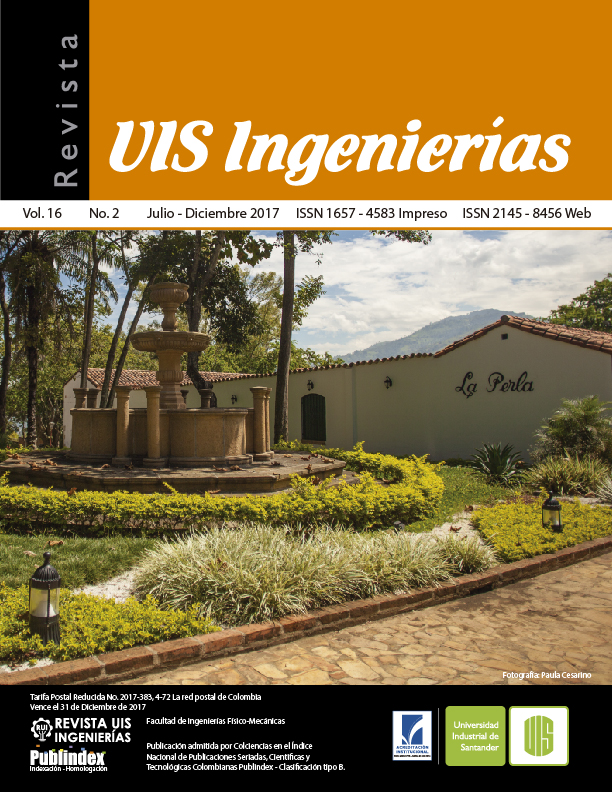Optimization algorithms applied in the real-time thermodynamics properties estimation during a material thermal treatment with microwaves
Published 2017-05-17
Keywords
- Parameter estimation,
- Microwave heating,
- Global optimization methods,
- Inverse problem
How to Cite
Abstract
This work considers the real-time prediction of thermal parameters for a cylindrical sample heated in a uniform electromagnetic field. The thermal conductivity ( ) and the heat capacity ( ) were estimated for the present case. The inner volumetric electromagnetic flux radiation process was modeled as uniform and constant in time. The spiral optimization algorithm (SOA), the vortex search (VS), the weighted attraction method (WAM), the unified particle swarm optimization (UPSO), the electromagnetic field optimization (EFO) and the self-regulated fret-width harmony search algorithm (SFHS) were used to solve the ill-posed inverse problem. Results showed that all employed algorithms correctly estimated these two parameter only if the signal-to-noise-ratio of the measured samples (simulated in this work) were above of 30 [dB]. Therefore, for practical purposes, these parameters can be estimated in real-time if a good experimental design and a correctly specified electronic instrumentation are available.
Downloads
References
- Necati Ozisik, “Introduction and concepts,” in Heat transfer - abasic approach, Internatio., A. Murphy and M. Eichberg, Eds. Singapore: McGraw-Hill Book Co, 1985, pp. 1–18.
- J. Osepchuk, “A History of Microwave Heating Applications,” IEEE Trans. Microw. Theory Tech., vol. 32, no. 9, pp. 1200–1224, 1984.
- National Research Council, “Microwave applications,” in Microwave Processing of Materials, Washington, DC: The National Academies Press., 1994.
- J. M. Catalá-Civera, A. J. Canós, P. Plaza-González, J. D. Gutiérrez, B. García-Baños, and F. L. Peñaranda-Foix, “Dynamic Measurement of Dielectric Properties of Materials at High Temperature During Microwave Heating in a Dual Mode Cylindrical Cavity,” IEEE Trans. Microw. Theory Tech., vol. 63, no. 9, pp. 2905–2915, 2015.
- L.-F. Chen, C. K. Ong, C. P. Neo, and V. V. Varadan, Microwave Electronics, Measurement and Materials Characterization, 1st ed. Wiltshire, Great Britain: John Wiley & Sons, 2004.
- M. J. Colaço, H. R. B. Orlande, and G. S. Dulikravich, “Inverse and optimization problems in heat transfer,” J. Brazilian Soc. Mech. Sci. Eng., vol. 28, no. 1, pp. 1–24, 2006.
- R. Dasa, “Identification of materials in a hyperbolic annular fin for a given temperature requirement,” Inverse Probl. Sci. Eng., vol. 24, no. 2, pp. 213–233, 2016.
- W. P. Adamczyk, R. A. Białecki, and T. Kruczek, “Retrieving thermal conductivities of isotropic and orthotropic materials,” Appl. Math. Model., vol. 40, pp. 3410–3421, 2015.
- M. J. Huntul, D. Lesnic, and M. S. Hussein, “Reconstruction of time-dependent coefficients from heat moments,” Appl. Math. Comput., vol. 301, pp. 233–253, 2017.
- F. Mohebbi and M. Sellier, “Estimation of thermal conductivity, heat transfer coefficient, and heat flux using a three dimensional inverse analysis,” Int. J. Therm. Sci., vol. 99, pp. 258–270, 2016.
- E.-G. Talbi, “Common Concepts for Metaheuristics,” in Metaheuristics, from Design to Implementation, 1st ed., New Jerey: John Wiley & Sons, 2009, pp. 1–79.
- K. Tamura and K. Yasuda, “Spiral Multipoint Search for Global Optimization,” in 2011 10th International Conference on Machine Learning and Applications and Workshops, 2011, pp. 470–475.
- B. Dogan and T. Olmez, “A new metaheuristic for numerical function optimization: Vortex Search algorithm,” Inf. Sci. (Ny)., vol. 293, pp. 125–145, 2015.
- G. Friedl and M. Kuczmann, “A New Metaheuristic Optimization Algorithm, the Weighted Attraction Method,” Acta Tech. Jaurinensis, vol. 8, no. 3, pp. 257–266, 2015.
- J. Kennedy and R. Eberhart, “Particle swarm optimization,” 1995 IEEE Int. Conf. Neural Networks (ICNN 95), vol. 4, pp. 1942–1948, 1995.
- K. E. Parsopoulos and M. N. Vrahatis, “UPSO: A unified particle swarm optimization scheme,” Lect. Ser. Comput. Comput. Sci., vol. 1, pp. 868–873, 2004.
- H. Abedinpourshotorban, S. Mariyam Shamsuddin, Z. Beheshti, and D. N. A. Jawawi, “Electromagnetic field optimization: A physics-inspired metaheuristic optimization algorithm,” Swarm Evol. Comput., vol. 26, pp. 8–22, 2016.
- Z. Geem, J. Kim, and G. V Loganathan, “A New Heuristic Optimization Algorithm: Harmony Search,” Simulation, vol. 76, no. 2, pp. 60–68, 2001.
- I. Amaya, J. Cruz, and R. Correa, “Harmony Search algorithm: a variant with Self-regulated Fretwidth,” Appl. Math. Comput., vol. 266, pp. 1127–1152, 2015.
- H. S. Carslaw and J. C. Jaeger, “The flow of heat in a infinite circular cylinder,” in Conduction of heat in solids, 2nd ed., Oxford University Press, 1959, pp. 187–213.
- Grup d’Innovació per la Millora de la Docència en Estructura Propietats i Processat de Materials, “Materials - Silicom Carbide.” [Online]. Available: http://www.ub.edu/cmematerials/es/content/carburo-de-silicio-sic. [Accessed: 16-Jun-2016].
- J. Vere Beck and A. Kenneth, “Introduction To Linear Estimation,” in Parameter Estimation in Engineering and Science, New York: John Wiley & Sons, 1977, pp. 130–212.

